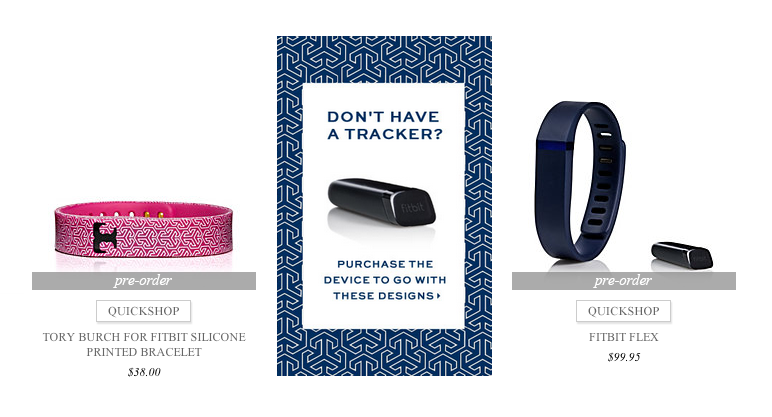
 Wearable technology may or may not be the next big digital thing. But at the very least, for a small segment of the early adopter segment, it’s already become a fashion statement.
Wearable technology may or may not be the next big digital thing. But at the very least, for a small segment of the early adopter segment, it’s already become a fashion statement.
Makers of wearable technology are coming to terms with this and are increasingly turning to the fashion community to do the one thing the tech community can’t: make a wearables more wearable for those who aren’t card-carrying members of the geek elite.
“The fashion industry says quite vocally that some wearables are ugly, they’d never carry them in their stores,” Sandra Lopez, director of marketing strategy, Intel New Devices Group, said. “We know that we don’t know how to design beautiful things people want to wear.”
Toward that end, Tory Burch entered into a new collaboration with activity tracker FitBit this week, resulting in accessories that make the fitness wearables actually look good. Last month, Diane von Furstenberg launched “Made for Glass,” a Google Glass collection. For its part, Apple, which has yet to publicly launch its wearable products, hired Burberry’s Angela Ahrendts in May.
Intel and the CFDA also announced at CES an ongoing partnership that’s trying to solve one major problem in the space: How do you bring fashion in at the beginning of a wearable-design process instead of tacking it on as an afterthought? What Intel is doing with designers is not only working with them on making new devices pretty (the company will launch a smart bracelet designed with Opening Ceremony this year) but also educating the industry on how wearables work. “We don’t want them to play catch up, we want them to be part of the journey help them define the standards,” said Lopez.
There’s also a margin play here, as the Tory Burch line is clearly a way to extend profits beyond just the sale of the device. Tory Burch’s line of official FitBit accessories can run you from $38 for a printed silicone bracelet cover to $195 for a brass cover that will “transform” your FitBit.
Bonus: Wearables that don’t make you look like a complete doofus might save you from being punched. A Credit Suisse analyst predicted in June that the market for wearable tech will increase to $50 billion in the next three to five years. And 50 percent of respondents in an NPD survey from earlier in the year said the design and look of Glass is extremely important to them. No one wants to look like a douchebag.
The Council of Fashion Designers of America has been pushing hard for more communication between the fashion community and the makers of geek-tech. The CFDA in October teamed up with eBay to get five American designers — including Rachel Zoe and Michelle Smith — to design unisex bracelets that double up as chargers.
There is precedent for this. In 2013, Motorola marketed the Moto X as a fashion accessory and got models to carry it down runways at Made Fashion Week. In 2008, HP worked with Vivienne Tam for a digital clutch at Fashion Week. Neither made much of an impact, though: Moto shuttered the factory in Texas that manufactured the phones this year.
“I think it’s cool, but if the hardware doesn’t actually function, no amount of French fabric is going to help,” said Lucy Farey-Jones, a wearable user and partner, executive strategy director at Venables Bell & Partners. She also made a distinction between fashion and design, and said that wearable tech should be going to design companies, not the “runway.”
Or maybe the companies have it all backwards. “I think there is huge potential in making old wearable tech cool,” said Farey-Jones. “Hearing aids, for one, look like crap.”
More in Marketing

Pandora is betting on AI agents to scale service and emotional selling during the peak holiday season
Pandora is using AI agents to scale customer service and replicate emotional in-store selling online, just as peak season puts pressure on margins and teams.

Rembrand’s CEO wants to grow virtual ad placements in streaming, and he’s looking elsewhere for models
Omar Tawakol wants to improve advertising within the streaming world, and is working with advertisers and publishers to improve that experience.

Marketers are keen to use generative AI in ad campaigns, but hidden costs lurk
Marketers across the industry want to use AI to cut down on time spent in creative production. It’s not so simple in practice.





